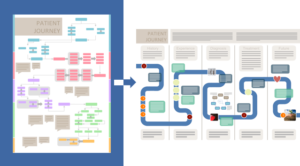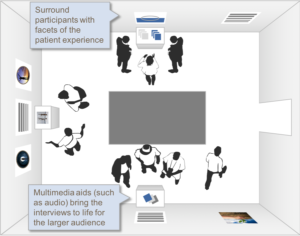How and Why to Execute Rare Disease Patient Journey Market Research
“You can’t understand someone until you’ve walked a mile in their shoes.”
We all appreciate the importance of empathy in patient interactions. However, this understanding is even more important in the world of rare diseases, because the emotional toll on patients and families can be substantial.
Consider these dynamics:
- Patients and families often face multi-year journeys before receiving an accurate diagnosis, turning the journey into an odyssey
- Patients and caregivers are forced into the role of disease expert because physicians don’t understand their rare disease
- Support networks may be limited even for those who have been properly diagnosed
- Access to treatment is often difficult, making it challenging for patients to initiate and adhere to therapy
The more you understand patients’ lives, the better you’re able to partner with and support them, and the more successful your brand will be.
By exploring the patient journey (which we define as the full patient experience from symptom onset to diagnosis and management), manufacturers can:
- Understand barriers to diagnosis, including misdiagnoses
- Determine which types of physicians may be appropriate targets for disease education
- Explore specific patient needs for education and support programs
- Evaluate barriers to treatment / adherence and explore potential solutions
So, how do you conduct patient journey market research that maximizes useful insights?
Based on our experience, here are the best practices:
Understand the lay of the land before speaking to patients
While patients have the deepest insight into living with symptoms and disease progression, KOLs can provide a helpful foundation. Understanding their perspective on how the differential diagnosis is made, which diagnostics are ordered, how to approach management, and their future outlook helps inform conversations with patients.
Understand the events, but don’t ignore the experience
“Patient journey” is often used as a synonym for “buying process.” In other words, teams focus on documenting events, but forget to include feelings. Emotions are inextricably linked with decision-making – particularly when dealing with a rare disease. So, rather than a decision tree, we think of the journey as a winding pathway. Brands can glean actionable insights by deeply examining the emotional influences on patient choices and actions and looking for opportunities to improve the experience. To uncover these emotions, we recommend projective techniques that help patients access non-rational processes driving decision-making and behaviors.

Make the most of your time
Asking patients to document part of the journey before a conversation helps organize their thoughts and reminds them of events that may have occurred years ago. A homework assignment prior to the interview helps patients get in the right mindset to discuss their broader journey. We often collect essential background information (e.g., age of onset, key symptoms, physicians seen) in a short online survey before the interview, an approach that captures useful demographic and buying process information while freeing up more time to explore emotional elements during the interview.
Don’t forget the family
Caregivers and family can be essential to understanding the patient journey. Caregivers can have a clearer understanding of how specific events unfolded and often take on a primary role in communicating with physicians and researching treatment. Meanwhile, caregivers and families have their own experiences with the burden of their loved one’s disease. Exploring caregiver and family perspectives on the journey often reveals useful (and even unexpected) opportunities to serve the entire patient family better.
Put on the white gloves to recruit
Despite what you might fear, it is possible to recruit rare disease respondents! It just takes some creative thinking to move beyond a traditional approach.
Key strategies include:
- Partnering with advocacy groups
- Networking with KOLs and centers of excellence
- Partnering with specialty pharmacies
- Connecting on social media
- Seeking referrals within the patient community
Most importantly, every communication with members of the rare disease community must be handled with the utmost sensitivity and respect. Demonstrating your commitment to the community starts with recruiting.
Bring your findings to life
The goal of any market research is to share findings that are usable and live on within your organization. Individual stories are one of the most powerful components of patient journey research, and it’s essential to communicate the insights without losing the essence of each patient. An infographic, poster, or immersion workshop that shares different components of the patient journey can bring findings to life.

As organizations push to ensure their thinking and actions align with patient needs, patient journey research can make an invaluable contribution to strategy. While there are challenges to conducting this type of research among people with rare diseases, their often-circuitous path to diagnosis and day-to-day struggles make understanding their odysseys all the more critical to developing meaningful brand strategy.
With the right approach, research often reveals hidden opportunities for improvement (in diagnosis, treatment initiation, and/or adherence), creating a win-win scenario for patients and manufacturers.
